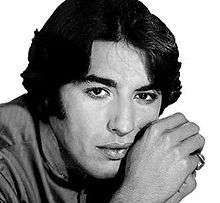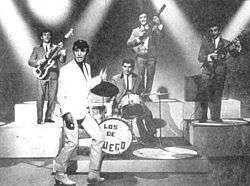Sandro de América
| Sandro | |
|---|---|
 Sandro in 1969 | |
| Background information | |
| Birth name | Roberto Sánchez-Ocampo |
| Also known as |
Sandro Sandro de América Gitano |
| Born |
August 19, 1945 Buenos Aires, Argentina |
| Died |
January 4, 2010 (aged 64) Mendoza, Argentina |
| Genres | Rock and roll, Latin pop |
| Occupation(s) | Musician, actor, singer |
| Instruments | Vocals, guitar, piano |
| Years active | 1960–2009 |
| Labels | CBS, RCA, EMI, Sonográfica Velvet, Universal Music, BMG Music, Sony music, Excalibur |
| Associated acts | Los de Fuego |
Roberto Sánchez-Ocampo (August 19, 1945 – January 4, 2010), better known by his artist names Sandro/Sandro de América ("Sandro of America"), Gitano (gypsy), and the Argentine Elvis, was a notable Argentine singer and actor. He is considered one of the first rock artists to sing in Spanish in Latin America. He edited 52 official records and sold 50 million copies although other sources state that he sold over 75 million.[1] Some of his most successful songs are Dame fuego, Rosa, Rosa, Quiero llenarme de ti, Penumbras, Porque yo te amo, Así, Mi amigo el Puma, Tengo, Trigal, Una muchacha y una guitarra. Only the single Rosa, Rosa sold 2 million copies, being also his most recognizable and famous song. Other of his hits, "Tengo", was placed 15th amongst the 100 best Argentine rock songs by both MTV channel and Rolling Stone magazine.
Sandro was also the first Latin American artist to sing at the Felt Forum at Madison Square Garden, in 1970, Sandro was the first singer to-do a via satellite concert in the world.on April 1970 that a concert was transmitted live to an entire region, namely the Western hemisphere. [2] In 2005 Sandro was awarded with a Latin Grammy honoring his career.
Biography
Sandro was born in Buenos Aires to Irma Nydia Ocampo and Vicente Sánchez in 1945. He was raised in the southern suburb of Valentín Alsina,[3] and learned to play the guitar as a child, identifying his music as Romani.[4] His paternal grandfather was Russian Rom from Hungary – Roma are known in Argentina as Gitanos (Gypsies).[3][5][6]
Initially, in his schooldays, he imitated the king of rock and roll Elvis Presley, but afterwards created a personal style that marked his career and became a pioneer in Spanish-language rock music. On November 10, 1971, he finally was able to see Presley live, at the Boston Garden, during a tour he did of that city. In 1961, he started the musical group Sandro & los de Fuego, which gained popularity on the TV show Sábados Circulares, and became widely known in the 1960s. With songs such as "Ave de Paso", "Atmósfera Pesada", "Quiero Llenarme de Ti", "Tengo", "¿A esto le llamas amor?", "Eres el demonio disfrazado" (cover of "(You're the) Devil in Disguise"), "Porque yo te amo", "Penumbras", "Una muchacha y una guitarra", "Trigal" or "Rosa Rosa", success of his career kept growing steadily.
Sandro also had the leading role in 11 films, including Quiero llenarme de ti ("I Want to Fill Myself with You" – 1969) and Subí que te llevo ("Hop On, I'll Give You a Ride" – 1980), and directed one feature, Tú me enloqueces ("You Drive Me Crazy"), in 1976.[7] His co-star in the latter film, Argentine actrees Susana Giménez, was offered a TV variety show after he refused to host it; Giménez's show, named Hola Susana, would become a ratings leader shortly after its 1987 launch.[8]
He also starred in two soap operas, notably Fue sin Querer ("I Didn't Mean to"), with Puerto Rican actress Gladys Rodríguez.
As mentioned earlier, he was the first Latino singer to sell out the Felt Forum at Madison Square Garden, (its top capacity being 5,000), five times during the 1970s. He also appeared a couple of times on The Ed Sullivan Show, as well as with Domenico Modugno, The Doors and many others.
Sandro's songs have been recorded by international artists such us Shirley Bassey, Liza Minnelli, Burt Bacharach, Dalida, Shirley MacLaine, Toto Cutugno, Nancy Wilson, Mary Hopkin, Loredana Berté, Umberto Tozzi, Gilbert Bécaud, Milva, Julio Iglesias, José Luis Rodríguez and Engelbert Humperdinck.
Argentine and other Latin American artists released an album in 1990 called Padre del rock en castellano ("Father of Spanish Rock") in his honor. Sandro continued releasing studio albums in the early 1990s and reappeared on stage in 1993 with a new show, that was presented at Teatro Gran Rex, a prestigious popular music venue in Buenos Aires, performing 18 attendance-record–breaking consecutive concerts. The news that he suffered from emphysema was made public in 1998, causing a great generalized concern among his followers from around the world. Sandro had been a self declared longtime cigarette smoking addict,[9] which undoubtedly was the main cause of the disease.
Health and death
On November 20, 2009, Sandro received a heart–lung transplant in Mendoza, Argentina; the operation was a success. Five days later, in a daily press conference held by his doctors, it was reported that Sandro, although still in intensive care, was breathing without a respirator and that he had started a slow recovery. Nevertheless, in the evening of January 4, 2010, 45 days after receiving the transplant, and after many complications, he died of septic shock, mesenteric ischemia and disseminated intravascular coagulation in the Hospital Italiano of Mendoza.[10]
Discography

- Sandro y los de Fuego (1965)
- Al calor de Sandro y los de Fuego (1965)
- El sorprendente mundo de Sandro (1966)
- Alma y fuego (1966)
- Beat Latino (1967)
- Quiero llenarme de ti (Vibración y ritmo) (1968)
- Una muchacha y una guitarra (1968)
- La magia de Sandro (1969)
- Sandro de América (1969)
- Sandro (1969)
- Muchacho (1970)
- Sandro en New York (1970)
- Sandro espectacular (1971)
- Te espero... Sandro (1972)
- Sandro Después de 10 años (1973)
- Sandro siempre Sandro (1974)
- Tú me enloqueces (1975)
- Sandro live in Puerto Rico(1975)
- Sandro (1976)
- Sandro un ídolo (1977)
- Querer como Dios manda (1978)
- Sandro (1979)
- Sandro (1981)
- Fue sin querer (1982)
- Vengo a ocupar mi lugar (1984)
- Sandro (1986)
- Sandro del '88 (1988)
- Volviendo a casa (1990)
- Con gusto a mujer (1992)
- Clásico (1994)
- Historia viva (1996)
- Para mamá (2001)
- Mi vida, mi música (2003)
- Amor gitano (2004)
- Secretamente palabras de amor (Para escuchar en penumbras) (2006)
- Sandro Hits (2009)
Filmography
- Convención de Vagabundos (1965)
- Tacuara y Chamarro, Pichones de Hombre (1967)
- Quiero Llenarme De Ti (1969)
- La Vida Continúa (1969)
- Gitano (1970)
- Muchacho (1970)
- Siempre Te Amaré (1971)
- Embrujo De Amor (1971)
- Destino De Un Capricho (1972)
- El Deseo de vivir (1973)
- Operación Rosa Rosa (1974)
- Tú Me Enloqueces (1976)
- Subí Que Te Llevo (1980)
- Fue sin querer (1980)
References
- ↑ "Sandro biography on Argentine rock site". Rock.com.ar. Retrieved 2012-01-05.
- ↑ "Sandro, the first Latin American singer to play New York's Madison Square Garden". Courant.com. Retrieved 2012-01-05.
- 1 2 Gente: Sandro, un mundo de sensaciones. Buenos Aires: Editorial Atlántida, 2006.
- ↑ (Spanish) Interview with Amparo Lavín A.
- ↑ (Spanish) El Diario de Carol online. Diario de mujer: La última bocanada de Sandro
- ↑ (Spanish) Sandro de América, una estrella que rehúsa extinguirse – Revista Gente Sur
- ↑ "Sandro". Cine Nacional. Retrieved 2012-01-05.
- ↑ Infobae: Sandro, el ídolo que pudo ser Susana Giménez (Spanish) Archived December 12, 2008, at the Wayback Machine.
- ↑ "''Clarín'' (12/19/2002)" (in Spanish). Clarin.com. December 19, 2002. Retrieved 2012-01-05.
- ↑ "A los 64 años, falleció Sandro". Infobae (in Spanish). 5 January 2010. Archived from the original on 8 January 2010.
External links
- Sandro de América at the Internet Movie Database
- Sandro de América at Cinenacional.com
- International José Guillermo Carrillo Foundation (Spanish)
- Site dedicated to Sandro (Spanish)
- News, discography, letters, photos (Spanish)
- News, Sandro de America en Franca Recuperación (Spanish)
- Sandro, su historia de vida (Spanish)